Imagine a fabric that repairs itself after a small tear, or a wall coating that purifies the air in your home. Picture roads that can generate electricity from passing cars, or medical implants that adapt and heal along with your body. These aren’t science fiction. They’re real innovations made possible by smart materials. These advanced materials are reshaping industries from healthcare to construction, and their applications are growing. Their great potential is bringing companies and research centers worldwide to push further investigation, developing a growing innovation hub fueled by a powerful blend of academic leadership, groundbreaking discoveries, and the growing contributions of agile SMEs and ambitious startups.
Innovation in Smart Materials
In this post, we’ll explore 10 smart materials you might not have heard of. If you’re looking for an in-depth analysis of R&D trends in this field, don’t miss our dedicated report packed with the latest insights on smart materials research.
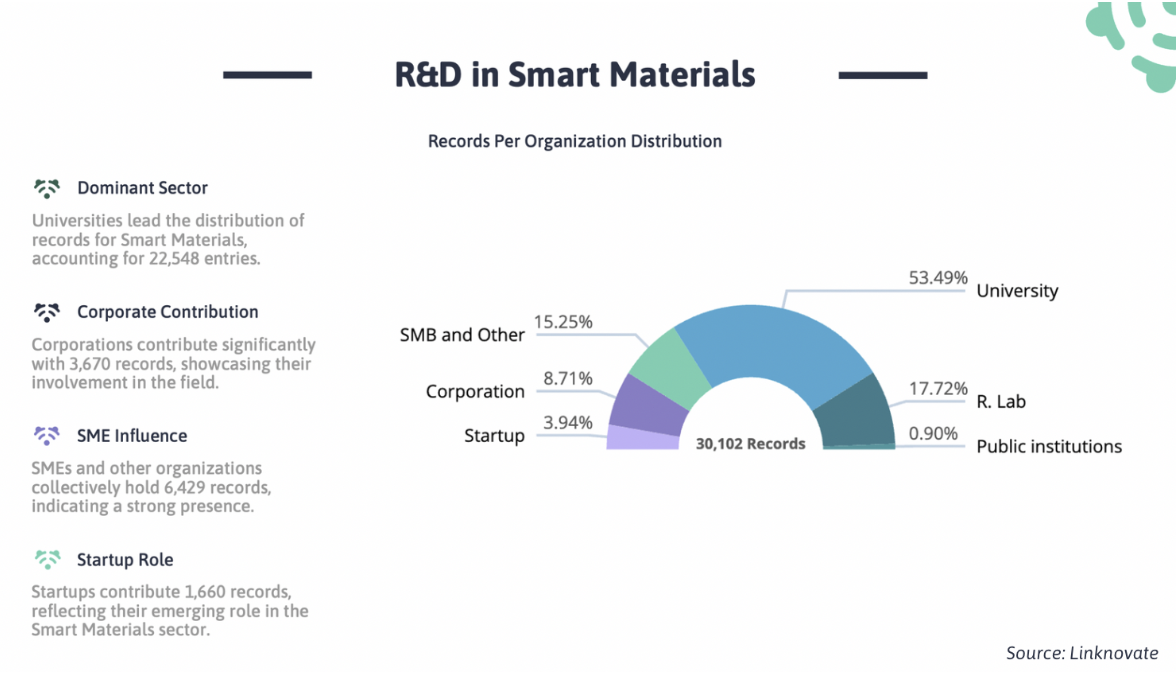
But what makes a material “smart”? Unlike traditional materials, which remain unchanged in varying conditions, smart materials have the capacity to actively respond to their surroundings. These materials, also known as “advanced functional materials,” can react to external stimuli such as temperature, light, pressure, or magnetic fields, altering their properties in a controlled and predictable manner. This adaptive capacity makes smart materials extremely valuable resources for industries seeking to create products that are more efficient, safe, and sustainable.
In fact, the fundamental difference between traditional materials and smart materials lies in what we could call their “memory” and “sensitivity” to the environment. While conventional materials simply fulfill their function without reacting to their surroundings, smart materials “sense” what’s happening around them and adapt accordingly. This allows them, for example, to store and release energy or automatically adjust to optimize their performance. In short, these materials represent a perfect symbiosis between technology and nature. They offer unprecedented versatility and opening a new world of possibilities in design and industrial efficiency.
Market growth: new demands and applications
With such promising properties, it’s no surprise that the smart materials market is experiencing accelerated growth. So much so that it’s estimated to reach a value of $98.2 billion by 2025, with an annual growth rate of 13.5%.
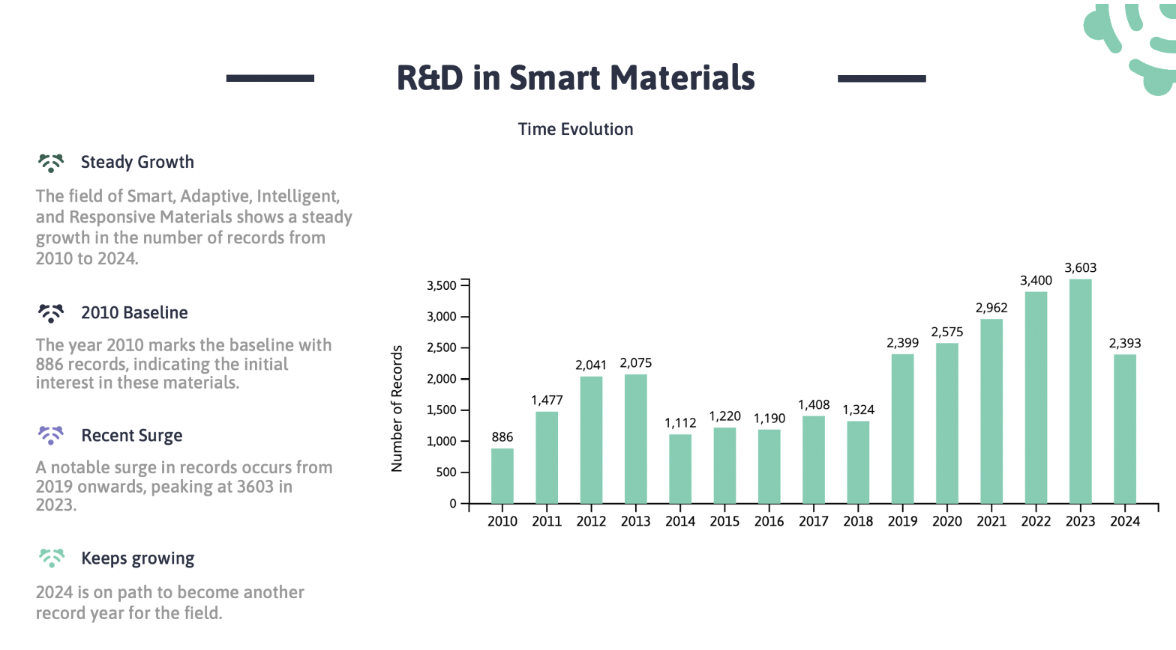
This market growth is being accompanied by growth in research and development in the topic. R&D in smart materials has shown a positive trend in the past few years, as suggested in the data from Linknovate’s platform InnoScout.
And this trend shows no signs of slowing down. Looking toward the future, projections for the smart materials market are optimistic. The high demand in sectors such as electronics, automotive, construction, and healthcare is accelerating the adoption of these materials in a market that continues to diversify. Leading companies such as Smart Material Corp, Arkema, and APC International and research centers worldwide are driving innovations with practical applications ranging from medical devices to automotive components. According to forecasts, by 2030, this market could experience even greater growth as demand for advanced materials in cutting-edge technologies continues to rise.
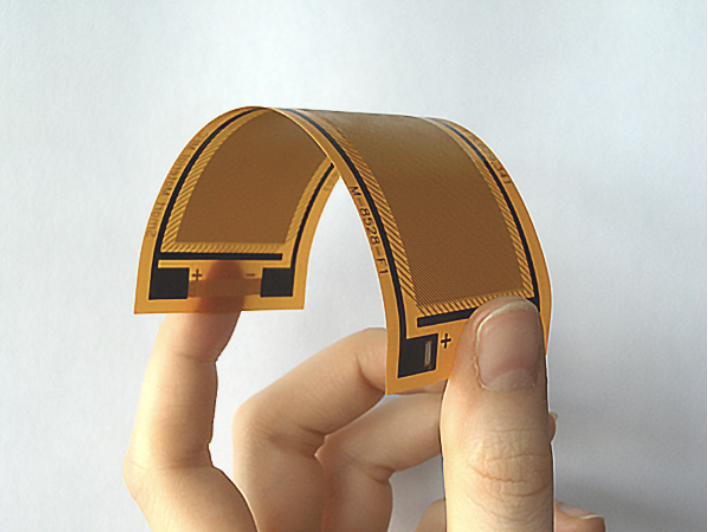
The new generation of smart materials
In this way, as demand grows for innovative solutions that can adapt to their surroundings, a new generation of smart materials is emerging, transforming industries and our daily lives. These materials go beyond traditional functionality, responding intelligently to stimuli and revolutionizing fields like civil engineering and medicine. Here are ten innovative applications of smart materials that are shaping the future:
1. 4D Printer for Smart Materials with Magnetic and Electromechanical Properties
Researchers at Universidad Carlos III have developed a 4D printer capable of creating smart materials with magnetophonic and electromechanical properties. These materials dynamically respond to external stimuli. this ability mades them ideal for advanced applications in soft robotics, medical devices, and energy storage systems. With this printing technology, it is possible to create complex structures that adapt to environmental changes.
2. Piezoelectric Tiles for Energy Production
In urban design, piezoelectric tiles have been developed that generate energy from pedestrian footsteps. This energy is used for different purposes, ranging from illumination to disinfection, like automatic cleaning systems in public spaces. This solution , for example, offers a sustainable and effective approach to urban hygiene. It demonstrates how piezoelectric materials can support public health and sustainability efforts in busy urban environments.
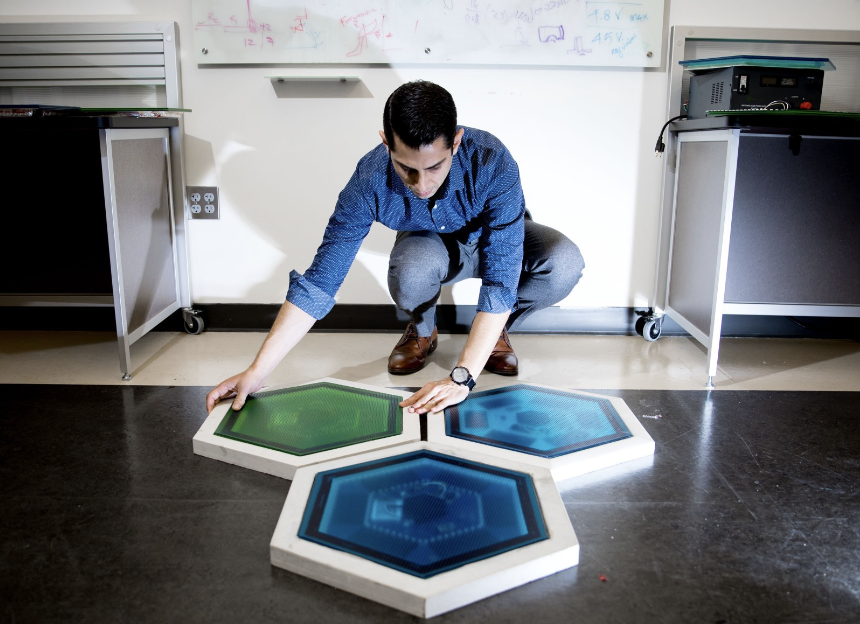
One company that exemplifies this type of innovation is Pavegen, specializing in piezoelectric tiles to generate energy from pedestrian footsteps. In 2019, Pavegen installed piezoelectric tiles in a London shopping street, Bird Street. The energy generated by passersby was used to power LED lighting and environmental sensors.
3. Shape Memory Alloys in Civil Engineering
To meet the need for more resilient infrastructure, shape memory alloys (SMA) are being applied in civil engineering. Particularly, in seismic zones to counter the action of heart quakes in buildings. Beams equipped with SMA bars are designed to return to their original positions after a seismic event, minimizing damage and ensuring greater structural stability. This self-centering capability has the potential to save lives and reduce repair costs in areas with frequent seismic activity.
4. Electrochromic Glass for Energy Efficiency
Electrochromic glass technology allows windows to adjust their tint level in response to electrical stimuli. Thos allows to control the amount of light and heat entering a building. This type of glass improves energy efficiency by reducing the need for heating and cooling, especially in large buildings. As energy efficiency becomes a priority, electrochromic glass is being implemented in commercial and residential projects to meet sustainable building standards.

One example of a company producing such glass is View Inc, a California company founded in 2007 that develops and markets smart electrochromic glass that automatically adjusts its tinting level in response to sunlight or through programmed controls. Its flagship product, View Smart Glass, combines advanced coatings with sensors and algorithms to create windows that automatically adjust to light conditions, helping to reduce building energy consumption by up to 20%. Specifically, View Smart Glass is designed for use in commercial buildings, hospitals, airports, hotels and high-end residences.
5. Self-Repairing Concrete
Self-repairing concrete is being studied as a potential advancement for durable infrastructure. Through advanced techniques, this concrete contains repair agents that activate when a crack forms, allowing it to self-repair. This type of innovation could lead to stronger, more sustainable structures, reducing maintenance costs and extending the lifespan of roads, bridges, and other critical infrastructure.
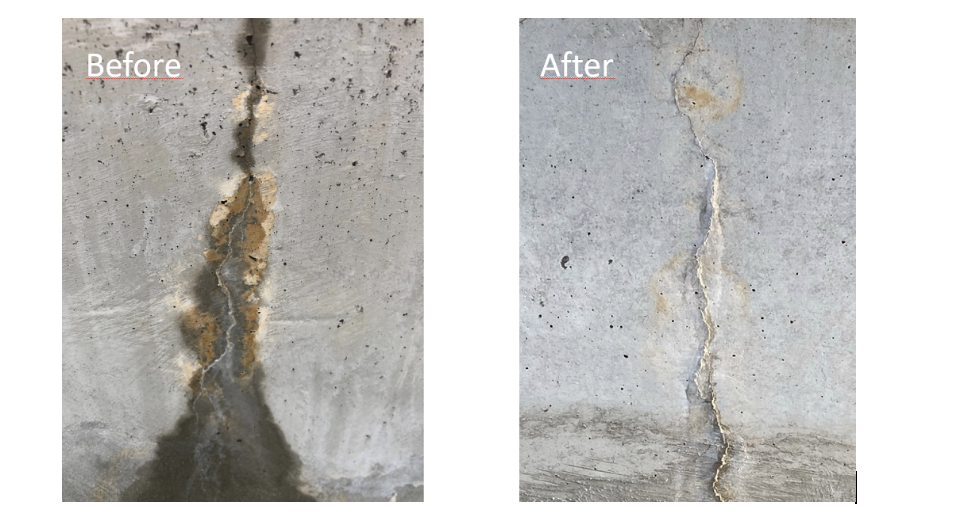
6. Polymers with Self-Healing Capabilities
Self-healing polymers hold great potential in electronics and energy storage. These materials can automatically restore themselves after damage, making them especially useful in batteries, supercapacitors, and flexible electronic devices. With this capability, devices made from self-healing polymers offer greater durability, especially in demanding environments, reducing waste and increasing the reliability of portable devices.
Evonik Industries is an example of a company positioned in the development of advanced polymers with self-healing capabilities. Designed for applications in flexible electronics, lithium-ion batteries and protective coatings, its materials, such as the VESTAMID® series, improve durability and reduce wear in electronic devices and energy storage systems, increasing their useful life. Overall, with a focus on sustainability, its solutions contribute to minimizing electronic waste and increasing the reliability of devices in demanding environments.
7. Thermochromic Materials in Smart Textiles
Thermochromic materials, which change color in response to temperature, are being integrated into smart textiles applications. These materials can adjust to the user’s temperature or environment, providing thermal regulation or acting as a visual temperature indicator. This application is especially valuable for industrial workers, offering visual signals for safety in extreme temperatures.
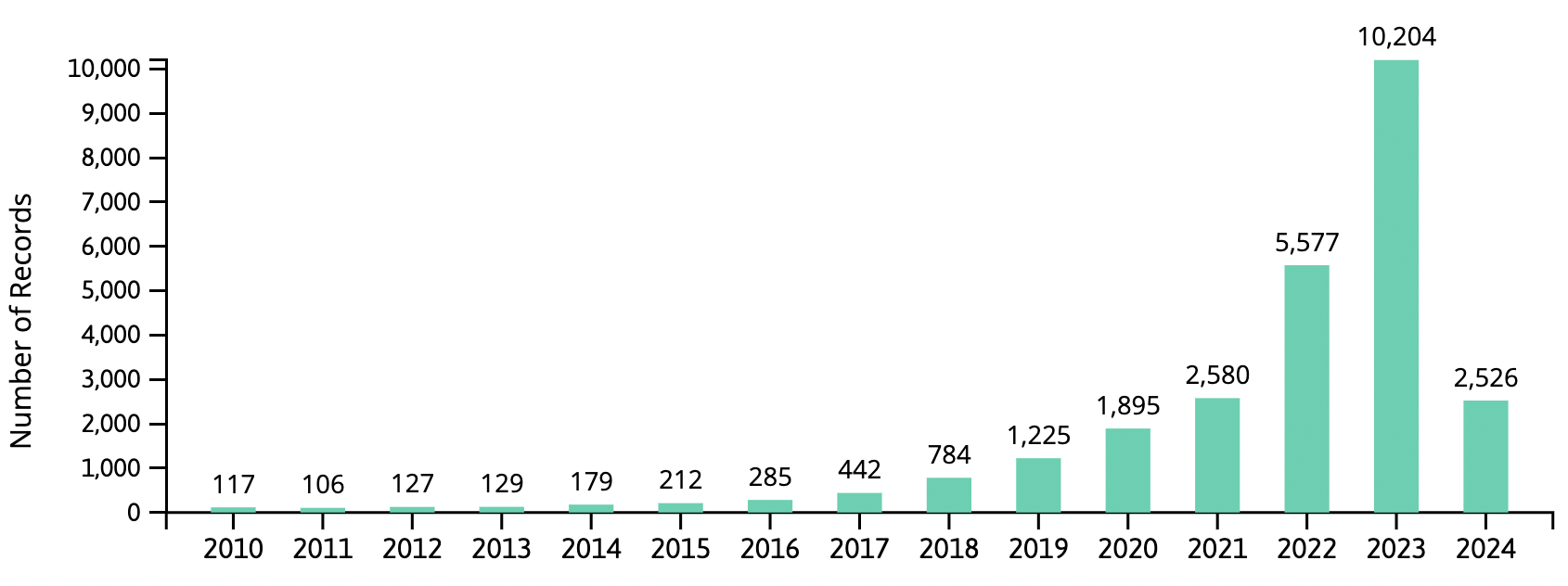
8. Sensors Based on Magnetorheological Materials
Magnetorheological materials are enhancing vibration control in industries such as automotive, civil engineering, and manufacturing. By changing their properties in response to magnetic fields, these materials are used in suspension systems, structural dampers, and machinery to reduce vibrations. Their ability to dynamically respond to different operational conditions adds safety and efficiency to these applications.
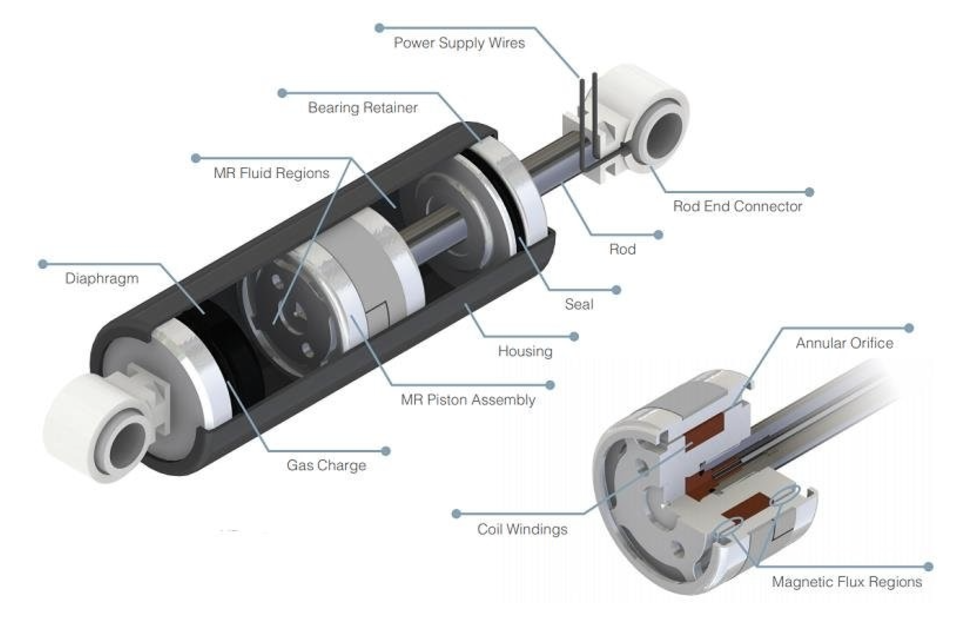
Lord Corporation (part of Parker Hannifin) stands out in the production of this type of smart materials with the development of magnetorheological materials and systems, such as its renowned MR Fluid Dampers, which adjust their properties in response to magnetic fields for automotive, civil engineering and industrial applications. Its dampers are used in adaptive suspensions for high-end vehicles, in bridges and buildings to mitigate seismic vibrations, and in machinery to improve efficiency and extend service life. With this technology, Lord Corporation drives solutions that improve safety, comfort and durability in demanding environments.
9. Photocatalytic Materials for Environmental Purification
Photocatalytic materials offer a promising solution to improve indoor air quality. These materials use light to break down contaminants, providing an effective method for air purification without generating harmful by-products. Applicable in homes, offices, and health settings, photocatalytic materials have great potential to improve indoor environments and promote better health.
For example, Reme Halo by RGF Environmental Group develops advanced air purification solutions. They use technologies such as photohydroionic oxidation and photocatalysis to improve indoor air quality. Its products include devices for HVAC systems, capable of eliminating bacteria, viruses, mold, mildew, and chemical contaminants.
10. Smart Hydrogels for Advanced Health-Tech
Smart hydrogels can respond to specific stimuli, such as pH, temperature or glucose concentration. They main applications are in healthcare and drug delivery systems. By synthesizing a biocompatible hydrogel with controlled swelling and contraction properties, it is possible to release drugs gradually and autonomously when changes in the physiological environment are detected. Smart hydrogels are also powerful in the cure wounds created by chronic conditions in conditions such as diabetes – with R&D in similar applications in wound healing growing especially in universities’ research labs.
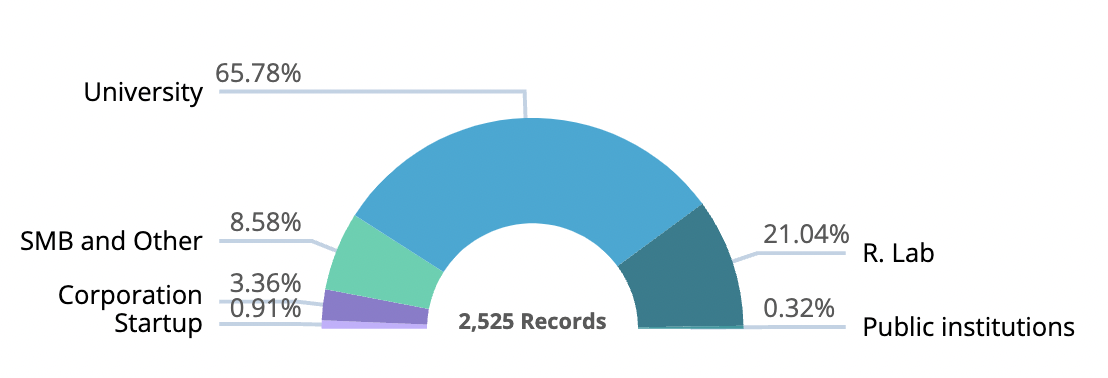
Each of these applications highlights the versatility and transformative potential of smart materials. As they evolve and diversify, they will play an increasingly central role in creating more responsive, efficient, and sustainable systems across multiple industries.
Linknovate Science S.L. en el marco del Programa ICEX Next, ha contado con el apoyo de ICEX y con la cofinanciación del fondo europeo FEDER. La finalidad de este apoyo es contribuir al desarrollo internacional de la empresa y de su entorno.








